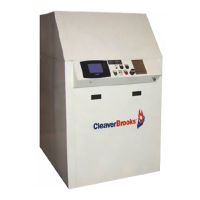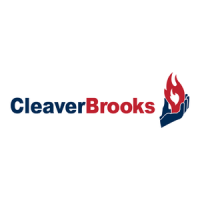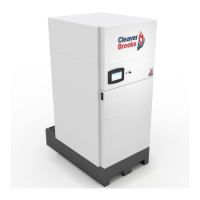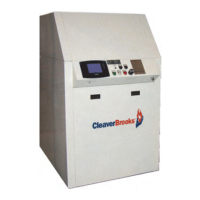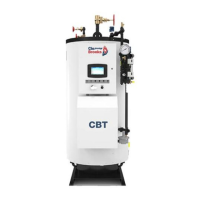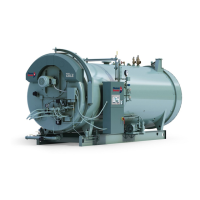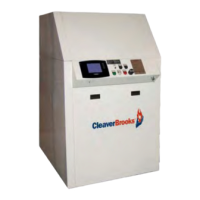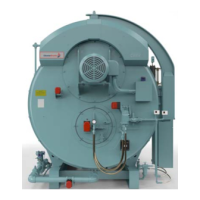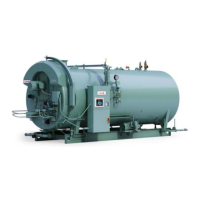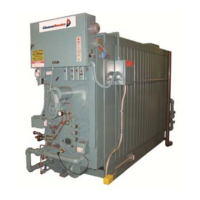Do you have a question about the CleaverBrooks ClearFire CFC-E and is the answer not in the manual?
Details on positioning the boiler, including lifting and base requirements for proper installation and accessibility.
Specifies environmental conditions, ventilation, and pressure requirements for the boiler room to ensure safe operation.
Guidelines for water chemistry, including limits for pH, chloride, and hardness, to maintain efficiency and prevent issues.
Recommendations for using glycol solutions for freeze protection, including concentration, monitoring, and corrosion prevention.
Requirements for connecting the gas supply, including pressure, volume, and gas train components for stable combustion.
Instructions for connecting hot water outlet and return piping, including safety valve installation and dual return design considerations.
Methods for handling boiler condensate, including neutralization, piping to drains, and options for single or multiple boilers.
Procedures for making electrical connections, emphasizing qualified personnel and proper wiring of components like blowers and ignition cables.
Illustrates electrical schematics for different boiler models, guiding the installation of control and power wiring for proper function.
Provides dimensions and instructions for attaching seismic brackets to ensure the boiler's stability in earthquake-prone areas.
Conditions and requirements for installing the boiler outdoors, including the need for an outdoor kit and suitability for moderate climates.
Explains the importance of proper flue gas exhaust venting and categorizes boilers based on vent pressure and temperature.
Details on venting horizontally through a wall when combustion air is drawn from the room, including installation guidelines.
Instructions for horizontal venting through a wall while drawing combustion air directly from outside the building.
Guidelines for vertical venting through the roof when combustion air is drawn from the interior of the building.
Procedures for vertical venting through the roof with combustion air drawn directly from the outside.
Provides tables and guidelines for sizing combustion air ducts and flue ducts based on boiler model and equivalent vent length.
Recommendations for venting multiple boilers, including individual venting, common breeching, and isolation dampers.
Specifies the need for adequate, uncontaminated air for combustion and ventilation, covering inside and outside air supply methods.
Details on positioning the boiler, including lifting and base requirements for proper installation and accessibility.
Specifies environmental conditions, ventilation, and pressure requirements for the boiler room to ensure safe operation.
Guidelines for water chemistry, including limits for pH, chloride, and hardness, to maintain efficiency and prevent issues.
Recommendations for using glycol solutions for freeze protection, including concentration, monitoring, and corrosion prevention.
Requirements for connecting the gas supply, including pressure, volume, and gas train components for stable combustion.
Instructions for connecting hot water outlet and return piping, including safety valve installation and dual return design considerations.
Methods for handling boiler condensate, including neutralization, piping to drains, and options for single or multiple boilers.
Procedures for making electrical connections, emphasizing qualified personnel and proper wiring of components like blowers and ignition cables.
Illustrates electrical schematics for different boiler models, guiding the installation of control and power wiring for proper function.
Provides dimensions and instructions for attaching seismic brackets to ensure the boiler's stability in earthquake-prone areas.
Conditions and requirements for installing the boiler outdoors, including the need for an outdoor kit and suitability for moderate climates.
Explains the importance of proper flue gas exhaust venting and categorizes boilers based on vent pressure and temperature.
Details on venting horizontally through a wall when combustion air is drawn from the room, including installation guidelines.
Instructions for horizontal venting through a wall while drawing combustion air directly from outside the building.
Guidelines for vertical venting through the roof when combustion air is drawn from the interior of the building.
Procedures for vertical venting through the roof with combustion air drawn directly from the outside.
Provides tables and guidelines for sizing combustion air ducts and flue ducts based on boiler model and equivalent vent length.
Recommendations for venting multiple boilers, including individual venting, common breeching, and isolation dampers.
Specifies the need for adequate, uncontaminated air for combustion and ventilation, covering inside and outside air supply methods.
| Model | ClearFire CFC-E |
|---|---|
| Type | Condensing Boiler |
| Design Pressure | 160 psi |
| Water Content | Varies by model |
| Heat Exchanger Material | Stainless Steel |
| Application | Commercial |
| Fuel Type | Natural Gas, Propane |
| Construction | Compact |
| Emissions | Low NOx |
| Efficiency | Up to 99% Thermal Efficiency |
